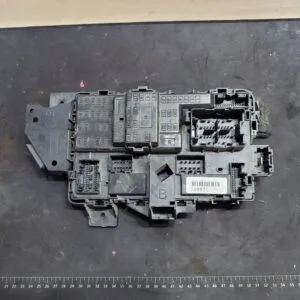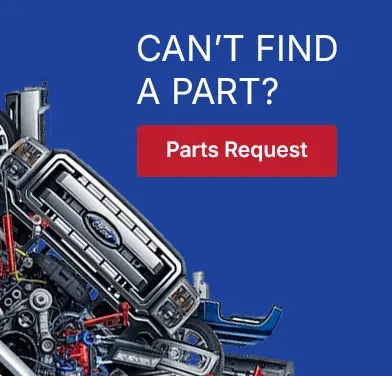No products in the cart.
Ford F250 Common Fuse Block / Fuse Box Problems (1999–2025)
Tired of dealing with ongoing electrical problems with your F-250? Take a look at our write-up below and see if any of these common issues discussed can help you out. Billy has melted down numerous electrical systems. Your issue will likely be much less than anything he has done.
Common Electrical Issues to Check First
 Parasitic Draws and Blown Fuses
Parasitic Draws and Blown Fuses
- Fuses tied to 4×4 modules (e.g. interior fuse #40 on 2010 6.4L diesel) may draw excessive current and cause battery drain.
- Fuse #22 (engine control circuit) keeps popping on 2004–2006 5.4L gas or diesel trucks, preventing start; often due to sensor or PCM short.
- Fuse #24 blowing repeatedly in HVAC circuit (e.g. heater blend door/AC clutch), rising from wiring or mechanical loading issues.
Physical Damage and Corrosion to Wiring or Fuses
- Fuse block under steering column in early 2000s trucks (e.g. 2004 F‑250) may corrode due to windshield leakage, causing intermittent loss of alternator, headlights, accessories. Replacement of the entire panel often resolves the issue.
- In some vans (similar Ford platforms), heavy blower or headlight fuses can overheat and melt the under‑hood fuse box housing—not yet common on F‑250 but notable.
Shorts and Internal Wiring Faults
- Blinker harness shorts causing front turn signal fuses to blow in older Gen 1 trucks (e.g. 1987, but same wiring design through early 2000s).
- Blower‑motor resistor or connector overheating and causing fuse #2 under‑hood to blow repeatedly (2007‑09 F‑250/F‑350).
Fuse Box Locations & Major Functions by Generation
Passenger‑Compartment Fuse Box
1999–2003 (Gen 1 Superduty)
- Located below/left of steering wheel near brake pedal; remove panel to access.
- Key fuse assignments (1999 example): #1 flasher, #3 cigar lighter & OBD‑II, #4 courtesy lamps & mirrors, #12 horn, #13 stop lamps, #24 blend‑door actuator / trailer‑tow battery charge (diesel HVAC issues tied here).
2002–2007 (Gen 1 headlights facelift)
- Interior fuse panel similar placement; fuse assignments evolve (#12 continues as cigar lighter/OBD, #11 washer wipers, #19 4×4 module, #22 engine/control/climate depending on fuel type). If you are terying to hunt down any electrical issues relating to the Gen 1, you may also want to review our Gen 1 Superduty Engine Guide to find out more common electrical problems.
2008–2010 (Gen 2) and 2011–2016 (Gen 3), and 2017–2022 (Gen 4)
- Panel still under dash left of steering; assignments shift with upfitter circuits, heated seats, ignition feed, fuel pump, etc. Upfitter and cluster fuses often in the 100+ numbers.
2020–2022 (Gen 4+)
- Passenger footwell on right side behind trim panel (crew cab configuration). Fuse numbering and functions more modular (#2 driver‑door switch, upfitter circuits, accessories).
Engine‑Compartment Fuse Box (Battery Junction / PDC)
1999 (4.6L /5.4L light‑duty)
Battery Junction Box in engine bay; fuses include:
- #1 Aux power socket
- #2 PCM power relay
- #3 headlamp relay, up to #24 powertrain/PCM functions.
2000–2001 Gen 1 Superduty
High‑current fuses:
- #5 PCM/fuel pump (diesel/gas difference)
- #10 power point
- #19 fuel pump motor
- #20–22 ignition switch feeds
- #23 blower motor
- #24 PCM power
- #26 locks
- #29 radio etc.
Diesel vs gas differences appear in coil ratings or module circuits.
2011–2017 (Gen 3) and 2017–2022 (Gen 4)
Engine fuse box on left side bay: includes high‑amp maxi fuses for:
- blower motor (#23)
- fuel pump (#66)
- upfitter, ABS pump, starter (#89)
- VPWR fuses (#33–37)
- 4×4 module fuses (#39/40/84 etc)
Engine‑Specific Differences and Common Issues by Engine Type
Gasoline V8 (5.4L, 6.2L)
Fuse #22 (engine control feed) failures; interior panel corrosion; HVAC fuse issues.
Diesel (6.0L, 6.4L, 7.3L, Powerstroke)
Parasitic draw on fuses serving 4×4/GEM modules; blend‑door/AC circuits tied into fuses causing heat issues; blower fuse melting connectors.
This tends to happen across all engine types, especially the 6.0L and 7.3L Diesels.
Interactive Wiring Diagrams
Under‑hood fuse holders and connectors may overheat if you have poor contact or excessive loads. A great resource for interactive wiring diagrams for your F250, we recommend Startmycar.com
How to Replace a Fuse Box Body or Module
Interior Fuse Panel (under‑dash)
- Disconnect the battery.
- Remove trim panel/fuse‑cover.
- Label connector bundles, release retaining clips from the back.
- Disconnect wiring harness from fuse block / GEM module.
- Install replacement of the correct generation and engine‑specific variant. Reconnect and reattach.
- Reinstall trim, reconnect battery, test.
Engine‑Compartment Fuse Box (Battery Junction Box / PDC)
- Ensure battery is disconnected.
- Remove cover and take photos of fuse layout.
- Replace damaged fuses, connectors, or entire housing if melted/corroded.
- For high‑amp fuses, ensure proper torque and secure connections.
- Reinstall securely, reconnect battery.
Maintenance Tips
- Inspect housing & connectors: moisture intrusion (e.g. from leaking windshield) can corrode fuse box and GEM module, especially early‑2000s trucks.
- HVAC/blower circuits: repeatedly blown fuses (like #2 or #24) often point to resistor or wiring failures rather than just component replacement.
- Parasitic draws: especially on diesel trucks with GPS or 4×4 electronic modules tied to interior fuse panels, fuses may not blow but still draw battery power over time.
- Always use OEM or reputable fuse brands (e.g. Buss) and correct rating; cheap aftermarket fuse holders can lead to heat and melting issues.
- Models 1999–2007 (Gen 1): cabin fuse box is prone to corrosion; engine‑bay BJB holds many high‑amp circuits; gas vs diesel variations.
- Models 2008–2025: more modular and variant‑specific layouts; common issues with blower resistor, fuse jamming, parasitic draw.
- Engine-specific fuse assignments and failures vary—diesel trucks may see 4×4 and HVAC related fuse strip draws; gas models face engine-control feed fuse blows.
Engine-Compartment Fuse Box (Power Distribution Center)
2011–2016 and for 2017–2022 F‑250
These trucks, especially with the 6.7L Powerstroke diesel, the under‑hood fuse box carries high‑amp and mini‑fuses with specific engine‑linked assignments. Check them.
From fuse and relay diagrams:
- Fuse 15: Diode feed for diesel fuel pump
- Fuse 27: Urea heater (diesel)
- Fuses 33–37, 74–76: VPWR lines feeding PCM/ECM, sensors, fuel systems differently beefed up per diesel vs gas.
- Fuses 39–40: 4×4 module hub/electronic lock
- Fuse 23: 40 A blower motor
- Fuse 66: 20 A fuel pump; 68: 10 A fuel pump relay coil
- Fuses 82–93: Auxiliary power points and seat/4×4 shift/heated‑seat loads
- Fuse 89: 40 A starter motor feed
- Relays labeled 1 (blower), 57 (fuel pump), 48 (run/start) etc.
2017–2022 (6.7 Powerstroke, Gen‑4+)
- Fuse 28, 64: Glow plug and NOx/urea sensors (diesel‑specific)
- Fuse 37: 60 A ABS pump
- Fuse 42: 40 A blower motor
- Fuse 65: 30 A fuel pump
- Fuses 32, 39: 4×4 module and starter solenoid
- Other fuses: rear heated seats (#27), power points (#35,36), BCM battery power feeds (#15,60), upfitter module (#57).
Passenger-Compartment Fuse Box (Cabin) Locations
1999– 2016
Located under steering column left side; large mini fuses handle HVAC blend‑doors, 4×4 module, OBDII, cigarette lighter, etc.
2020–2022
Moved to passenger‑footwell right side behind trim panel. Cabin fuse assignments vary by model year and feature set (upfitter circuits appear in later years).
We hope some of this helped. If you have any issues, please give us a call or get directions to visit the store. We are happy to help troubleshoot and we’ll even hook you up with some merch like a t-shirt or koozie. Every truck is different! If you are located near Orlando, FL feel free to stop by and we’ll gladly see if we can help you figure out any issues you may have.
The Patriotic Philosopher of Possum County Billy Hill is what happens when a six-pack of root beer, a John Deere hat, and the U.S. Constitution have a baby in the back of a pickup truck. Hailing from the grand hills of somewhere-between-here-and-there, Billy proudly considers himself a “hillbilly” — but with a PhD in common sense and a minor in wrestling raccoons off his porch. With a mullet that flows like a bald eagle in slow motion and a wardrobe that screams “Walmart clearance aisle patriotism,” Billy doesn’t just love America — he is America. He celebrates the 4th of July so hard his neighbors file noise complaints with the bald eagle sanctuary three counties over. Billy’s life philosophy is simple: “If it ain’t broke, duct tape it anyway for extra freedom.” He doesn’t take life too seriously because, as he puts it, “Ain’t no point stressin’ when you got barbecue sauce and a recliner.” He believes everything in life can be solved with a grill, a beer, or a rousing debate about which state has the best gas station snacks. Billy once tried to start his own political party: The Red, White, and Brew Party: its platform consisting entirely of fireworks, lawn chairs, and banning low-fat anything. Whether he’s hunting invisible squirrels in flip-flops or giving unsolicited wisdom like “You can’t buy happiness, but you can buy bacon,” Billy Hill is the national treasure no one asked for, but America somehow deserves.

 Parasitic Draws and Blown Fuses
Parasitic Draws and Blown Fuses
